2023届高考英语语法之谓语动词的时态、被动语态和主谓一致(时态)课件(35张)
文档属性
| 名称 | 2023届高考英语语法之谓语动词的时态、被动语态和主谓一致(时态)课件(35张) |  | |
| 格式 | pptx | ||
| 文件大小 | 1.7MB | ||
| 资源类型 | 教案 | ||
| 版本资源 | 通用版 | ||
| 科目 | 英语 | ||
| 更新时间 | 2022-09-17 19:48:50 | ||
图片预览


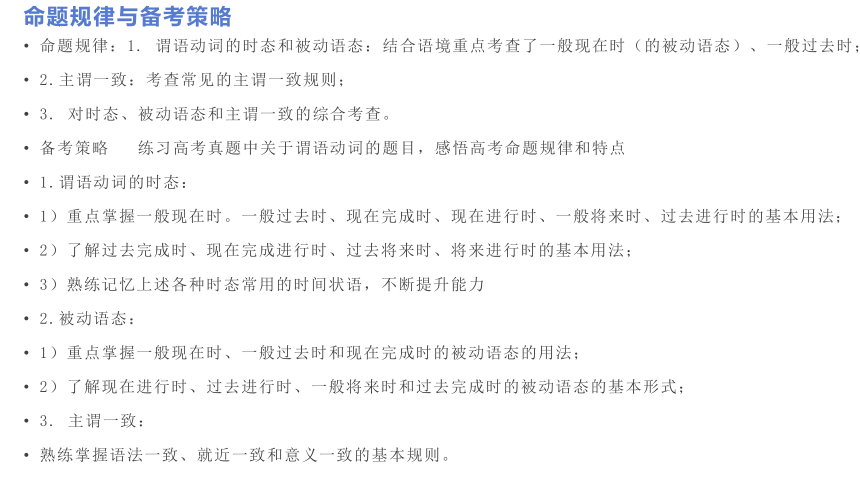
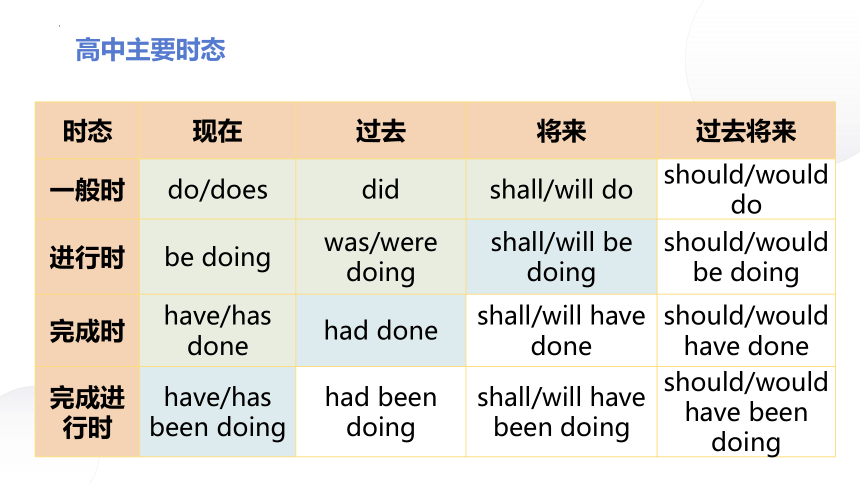
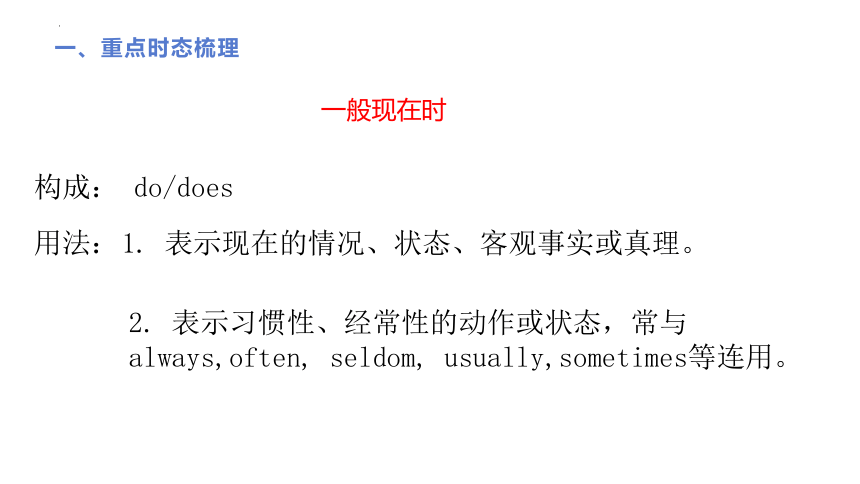
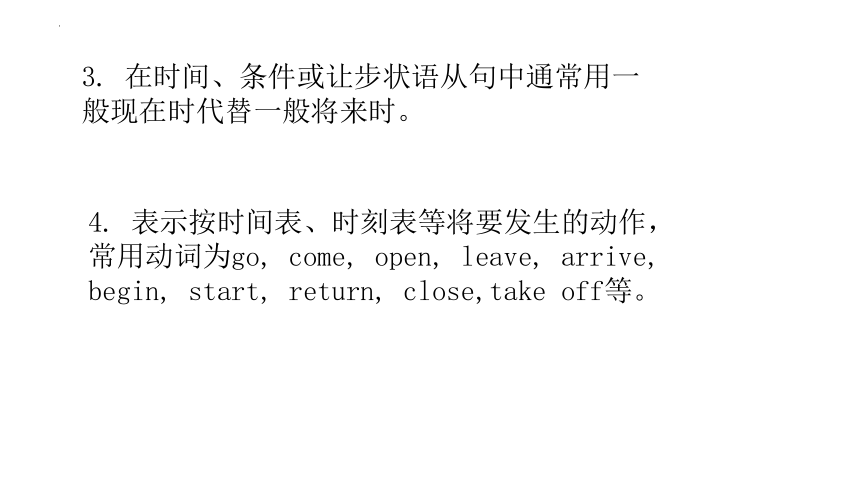
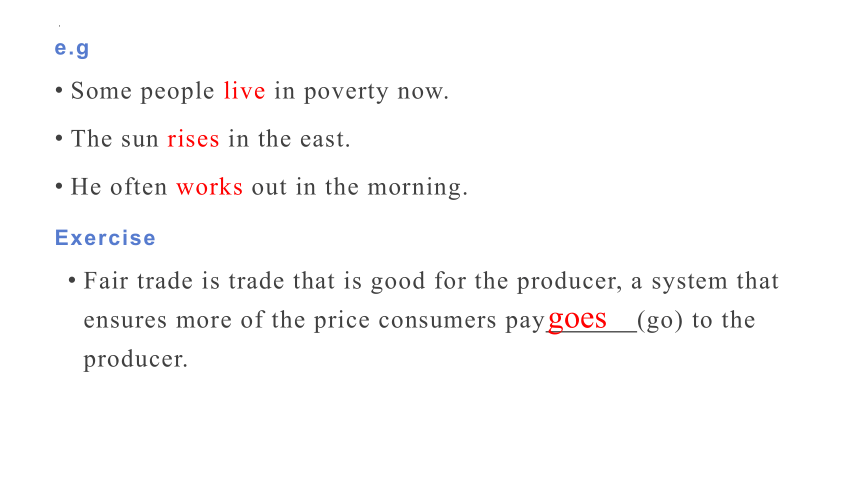


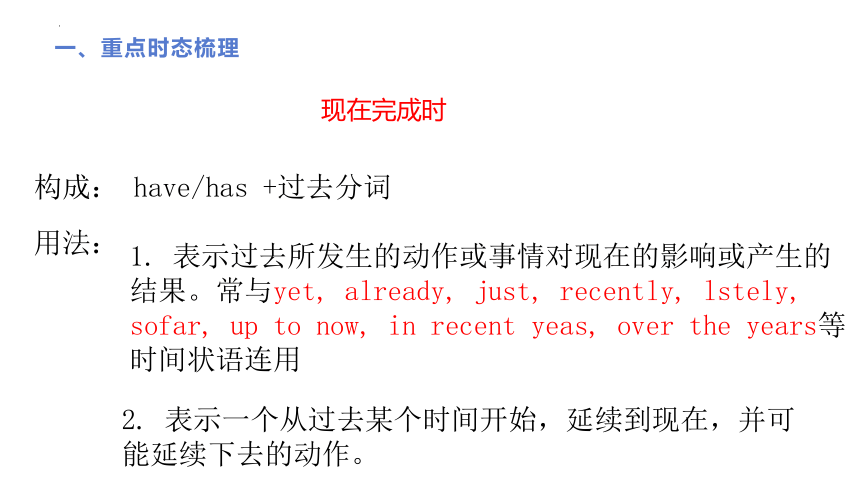
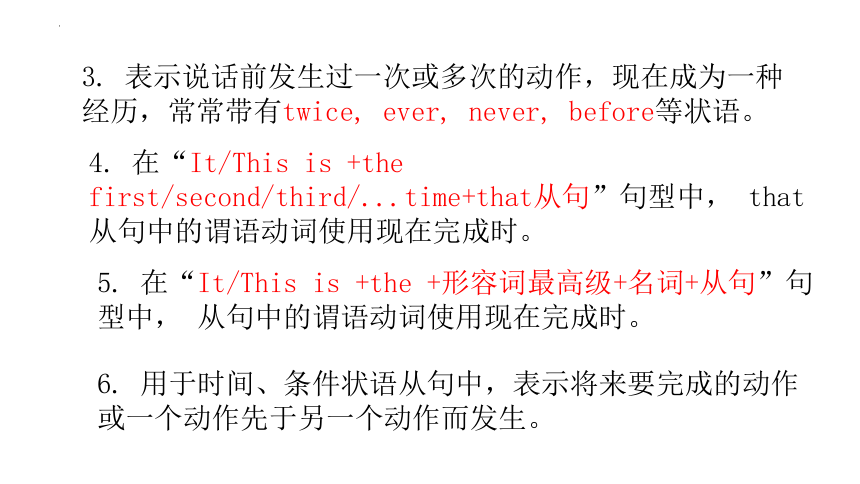
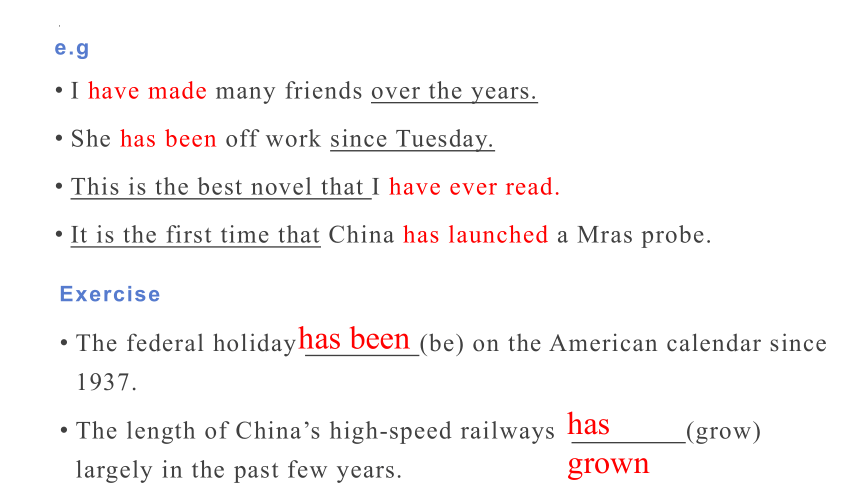
文档简介
(共34张PPT)
2023届高考英语语法之谓语动词的时态、被动语态和主谓一致(时态)
考情探究
统计题型 语法填空
高考考点 时态、主谓一致 被动语态
新高考 2022 were(be) is designed(design)
2021 was(be)
2020 ①formed(form)②is (be) are called (call)
合计 4 2
命题规律与备考策略
命题规律:1. 谓语动词的时态和被动语态:结合语境重点考查了一般现在时(的被动语态)、一般过去时;
2.主谓一致:考查常见的主谓一致规则;
3. 对时态、被动语态和主谓一致的综合考查。
备考策略 练习高考真题中关于谓语动词的题目,感悟高考命题规律和特点
1.谓语动词的时态:
1)重点掌握一般现在时。一般过去时、现在完成时、现在进行时、一般将来时、过去进行时的基本用法;
2)了解过去完成时、现在完成进行时、过去将来时、将来进行时的基本用法;
3)熟练记忆上述各种时态常用的时间状语,不断提升能力
2.被动语态:
1)重点掌握一般现在时、一般过去时和现在完成时的被动语态的用法;
2)了解现在进行时、过去进行时、一般将来时和过去完成时的被动语态的基本形式;
3. 主谓一致:
熟练掌握语法一致、就近一致和意义一致的基本规则。
高中主要时态
时态 现在 过去 将来 过去将来
一般时 do/does did shall/will do should/would do
进行时 be doing was/were doing shall/will be doing should/would be doing
完成时 have/has done had done shall/will have done should/would have done
完成进行时 have/has been doing had been doing shall/will have been doing should/would have been doing
一、重点时态梳理
一般现在时
构成: do/does
用法:
1. 表示现在的情况、状态、客观事实或真理。
2. 表示习惯性、经常性的动作或状态,常与always,often, seldom, usually,sometimes等连用。
3. 在时间、条件或让步状语从句中通常用一般现在时代替一般将来时。
4. 表示按时间表、时刻表等将要发生的动作,常用动词为go, come, open, leave, arrive, begin, start, return, close,take off等。
e.g
Some people live in poverty now.
The sun rises in the east.
He often works out in the morning.
Fair trade is trade that is good for the producer, a system that ensures more of the price consumers pay (go) to the producer.
Exercise
goes
一、重点时态梳理
一般过去时
构成: did
用法:
1. 表示过去某时发生的动作或存在的状态,常与just now, in the past, the other day,...ago等表示过去的时间状语连用。
2. 表示过去时间内连续发生的几个动作。
3. 表示过去时间内经常性。习惯性的动作或状态。
注意: want/ hope/ think/ intend等动词的一般过去时往往表示“本来,原来”的意义。
e.g
The other day I came across a friend in the street.
She glanced at me and then made a gesture.
I usually stayed up to do my homework in the past.
Tianzhou-2 (arrive) at Tianhe in May 2021, delivering supplies for the Shenzhou-12 crew.
A few months after he had arrived in China, Mr.Smith (fall) in love with the people and culture there.
Exercises
arrived
fell
一、重点时态梳理
现在完成时
构成: have/has +过去分词
用法:
1. 表示过去所发生的动作或事情对现在的影响或产生的结果。常与yet, already, just, recently, lstely, sofar, up to now, in recent yeas, over the years等时间状语连用
2. 表示一个从过去某个时间开始,延续到现在,并可能延续下去的动作。
3. 表示说话前发生过一次或多次的动作,现在成为一种经历,常常带有twice, ever, never, before等状语。
4. 在“It/This is +the first/second/third/...time+that从句”句型中, that从句中的谓语动词使用现在完成时。
5. 在“It/This is +the +形容词最高级+名词+从句”句型中, 从句中的谓语动词使用现在完成时。
6. 用于时间、条件状语从句中,表示将来要完成的动作或一个动作先于另一个动作而发生。
e.g
I have made many friends over the years.
She has been off work since Tuesday.
This is the best novel that I have ever read.
It is the first time that China has launched a Mras probe.
The federal holiday (be) on the American calendar since 1937.
The length of China’s high-speed railways (grow) largely in the past few years.
Exercise
has been
has grown
一、重点时态梳理
现在进行时
构成: am/is/are+现在分词
用法:
1. 表示现在或现阶段正在进行的动作或发生的事情等
2. 表示按计划或安排将要进行的动作,这类动词主要有: go, come, leave, stay, start, arrive,land, meet, move, return, stop, do等
e.g
Now I am planning our schedule for the trip.
We are leaving school on one year’s time.
“The moment is coming soon”, he thought to himself.
I’m busy right now. I (fill) in an application form for a new job.
Exercise
am filling
一、重点时态梳理
一般将来时
构成: 用法
will/shall +动词原形 表示现在看来以后要发生的动作或存在的状态
表示说话人临时做出的决定
is/am/are going to+动词原形 表示打算、计划、决定要做的事或肯定要发生的事
表示说话人根据已有的事实或迹象,推测某事即将发生
is/am/are about to+动词原形 表示打算或根据安排即将发生的动作。它不与表示具体时间的状语连用,但可以与when引导的时间状语从句连用
is/am/are to+动词原形 表示按计划或安排要做的事情
表示按职责、义务将要发生的动作
过去进行时
构成: was/were+现在分词
用法:
1. 表示过去某一时刻或某阶段正在发生的动作,常有表示过去时间的状语。
2. 表示某段时间内持续进行的动作。
3. 表示运动和位置移动的动词可以用过去进行时表示过去将来时。这类动词主要有:leave, start, arrive, go, come等。
一、重点时态梳理
将来进行时
构成:will/shall+be doing
用法:
表示将来某一时刻正在进行的动作。
At this time tomlorrow, I will be lying on the beach.
二、一般时态梳理
过去完成时
构成: had+过去分词
用法:
1. 过去完成时表示在过去某一时间或动作之前已经发生或完成了的动作,即“过去的过去( past-in-the-past )”。
----|-------------------------- |-------------------------------|---------------------------->
过去的过去 过去 现在
She had learned some English before she came to the institute.
二、一般时态梳理
They had already had breakfast before they arrived at the hotel.
She had finished writing the passage by 10: 00 this morning.
He had learnt English for ten years when he graduated.
2. 表示从过去某一时间开始,一直延续到过去的另一时间的动作,常用的时间状语有:by/until/before/ by the end of +过去的某一时间
I had intended to see you, but I was busy.
They had hoped to see you off at the airport, but they got there too late.
3. intend, mean, hope, want, plan, suppose, expect, think, propose, wish 等动词可以用过去完成时表示过去未能实现的计划、设想、意图或希望等.
I had hardly entered the classroom when the bell rang.
No sooner had he got to the station than the bus arrived.
4. 过去完成时可以用于 hardly ... when ...或 no sooner ... than ... 等结构,表示“一……就……”。
It is the first time that she has sung in public.
It was the first time that she had sung in public.
5. 用在“It was the+序数词或最高级+that+…”;
VS
Tom was offered the same suitcase his father and grandfather _____________ (take) with them to school.
He kept looking at her, wondering where he ___________(see) her before.
To my delight, I found the pen that I ______________(lose) under the bed in my bedroom.
---- What were you doing when I phoned you
----- Well, I ______________(finish) my work. I ______________ (talk) with my mother.
It was the first time that she ____________ (fly) to London, and she seemed quite excited.
It was the first time that she ____________ (fly) to London, and she seemed quite excited.
He insisted that he___________ (do) nothing wrong and he should be set free at once.
By the time he was ten years old, he_______________(complete) university.
They said the production costs of their company ________(reduce).
John, who got married only last week, spent $3000 more than he _____________ (plan) for the wedding.
The manager is said ____________(come) back from Paris where he __________ (meet) European business partners
现在完成进行时
构成: have/has been doing
用法:
现在完成进行时表示某动作从过去某个时间开始,一直延续到现在,并且还有可能持续下去。
Those dogs have been barking for hours.
We have been waiting for him for two hours.
二、一般时态梳理
现在完成进行时
She is very tired. She’s been working all morning.
I have been waiting for an hour and a half.
1.持续性
We’ve been making the same mistakes these days.
Jim has been calling Betty every night for the past week.
2.重复性
3.感彩
现在完成进行时
She is very tired. She’s been working all morning.
I have been waiting for an hour and a half.
We’ve been making the same mistakes these days.
Jim has been calling Betty every night for the past week.
现在完成进行时所用的时间状语:
all day / month
this month / week / year
these days
recently / lately
in the past few + 时间段
since +时间点
for + 时间段...
现在完成进行时 vs 现在完成时
He has cleaned the window.
He has been cleaning the window.
他把窗户擦干净了。(动作已完成)
他一直在擦窗户。(动作不一定完成)
1. 现在完成时强调动作的完成,而现在完成进行时强调动作的延续和反复
He has met the girl in the library again.
He has been meeting a girl in the library lately.
现在完成进行时 vs 现在完成时
Tom _______________ (ride) horses the whole morning.
Tom ___________ (ride) horses three times this morning.
2. 现在完成进行时表示反复的,连续的动作,不与表示次数、频度的词连用
has been riding
has ridden
现在完成进行时 vs 现在完成时
Who has been eating my apples?
Who has eaten my apples?
3.现在完成进行时比较生动,有时含有明显的感彩,而现在完成时往往只说明一个事实,一种影响或结果。
现在完成进行时 vs 现在完成时
He __________________ (paint) for decades amd he says he sees no possibility of quitting his job.
4. 在表示动作的延续时,虽然既可用现在完成时,也可用现在完成进行时,但在明确表示动作还要持续下去时,应用现在完成进行时。
has been painting
Please come tomorrow afternoon. Tomorrow evening I _________
(have) a party.
2. You should go to bed for your well being. You _________ (watch)
TV for 5 hours.
3. I'm tired out. I _____________ (shop) all afternoon, and I don't
seem to have finished anything.
4. We _____________ under extreme pressure at the moment.
5. Dear friend, I ___________ (sit) on a train to Fudan University when you read this letter.
6. I ____________ (walk) in the street when someone called me.
will be having
have been watching
have been shopping
will be sitting
are working
was walking
Kate has set a new record, that is, the sales of her latest book ____________ (reach) 60 million so far..
By next Monday, she _____________(study)here for three years.
By the end of last week he ___________ (write) two papers
By the time you arrive, he _____________ (finish) the job.
Years ago we didn't know this, but recent science________(show) that people who don't sleep well soon get ill.
I found the lecture hard to follow because it ________ (start) when I arrived.
have reached
will have studied
will have finish
has shown
had written
had started
过去将来时
构成: 用法
would/should +动词原形 表示从过去的某一时间看将要发生的动作或存在的状态
was/were going to+动词原形 表示过去某时计划、打算做某事
was/were about to+动词原形 表示过去某时即将做某事
二、一般时态梳理
2023届高考英语语法之谓语动词的时态、被动语态和主谓一致(时态)
考情探究
统计题型 语法填空
高考考点 时态、主谓一致 被动语态
新高考 2022 were(be) is designed(design)
2021 was(be)
2020 ①formed(form)②is (be) are called (call)
合计 4 2
命题规律与备考策略
命题规律:1. 谓语动词的时态和被动语态:结合语境重点考查了一般现在时(的被动语态)、一般过去时;
2.主谓一致:考查常见的主谓一致规则;
3. 对时态、被动语态和主谓一致的综合考查。
备考策略 练习高考真题中关于谓语动词的题目,感悟高考命题规律和特点
1.谓语动词的时态:
1)重点掌握一般现在时。一般过去时、现在完成时、现在进行时、一般将来时、过去进行时的基本用法;
2)了解过去完成时、现在完成进行时、过去将来时、将来进行时的基本用法;
3)熟练记忆上述各种时态常用的时间状语,不断提升能力
2.被动语态:
1)重点掌握一般现在时、一般过去时和现在完成时的被动语态的用法;
2)了解现在进行时、过去进行时、一般将来时和过去完成时的被动语态的基本形式;
3. 主谓一致:
熟练掌握语法一致、就近一致和意义一致的基本规则。
高中主要时态
时态 现在 过去 将来 过去将来
一般时 do/does did shall/will do should/would do
进行时 be doing was/were doing shall/will be doing should/would be doing
完成时 have/has done had done shall/will have done should/would have done
完成进行时 have/has been doing had been doing shall/will have been doing should/would have been doing
一、重点时态梳理
一般现在时
构成: do/does
用法:
1. 表示现在的情况、状态、客观事实或真理。
2. 表示习惯性、经常性的动作或状态,常与always,often, seldom, usually,sometimes等连用。
3. 在时间、条件或让步状语从句中通常用一般现在时代替一般将来时。
4. 表示按时间表、时刻表等将要发生的动作,常用动词为go, come, open, leave, arrive, begin, start, return, close,take off等。
e.g
Some people live in poverty now.
The sun rises in the east.
He often works out in the morning.
Fair trade is trade that is good for the producer, a system that ensures more of the price consumers pay (go) to the producer.
Exercise
goes
一、重点时态梳理
一般过去时
构成: did
用法:
1. 表示过去某时发生的动作或存在的状态,常与just now, in the past, the other day,...ago等表示过去的时间状语连用。
2. 表示过去时间内连续发生的几个动作。
3. 表示过去时间内经常性。习惯性的动作或状态。
注意: want/ hope/ think/ intend等动词的一般过去时往往表示“本来,原来”的意义。
e.g
The other day I came across a friend in the street.
She glanced at me and then made a gesture.
I usually stayed up to do my homework in the past.
Tianzhou-2 (arrive) at Tianhe in May 2021, delivering supplies for the Shenzhou-12 crew.
A few months after he had arrived in China, Mr.Smith (fall) in love with the people and culture there.
Exercises
arrived
fell
一、重点时态梳理
现在完成时
构成: have/has +过去分词
用法:
1. 表示过去所发生的动作或事情对现在的影响或产生的结果。常与yet, already, just, recently, lstely, sofar, up to now, in recent yeas, over the years等时间状语连用
2. 表示一个从过去某个时间开始,延续到现在,并可能延续下去的动作。
3. 表示说话前发生过一次或多次的动作,现在成为一种经历,常常带有twice, ever, never, before等状语。
4. 在“It/This is +the first/second/third/...time+that从句”句型中, that从句中的谓语动词使用现在完成时。
5. 在“It/This is +the +形容词最高级+名词+从句”句型中, 从句中的谓语动词使用现在完成时。
6. 用于时间、条件状语从句中,表示将来要完成的动作或一个动作先于另一个动作而发生。
e.g
I have made many friends over the years.
She has been off work since Tuesday.
This is the best novel that I have ever read.
It is the first time that China has launched a Mras probe.
The federal holiday (be) on the American calendar since 1937.
The length of China’s high-speed railways (grow) largely in the past few years.
Exercise
has been
has grown
一、重点时态梳理
现在进行时
构成: am/is/are+现在分词
用法:
1. 表示现在或现阶段正在进行的动作或发生的事情等
2. 表示按计划或安排将要进行的动作,这类动词主要有: go, come, leave, stay, start, arrive,land, meet, move, return, stop, do等
e.g
Now I am planning our schedule for the trip.
We are leaving school on one year’s time.
“The moment is coming soon”, he thought to himself.
I’m busy right now. I (fill) in an application form for a new job.
Exercise
am filling
一、重点时态梳理
一般将来时
构成: 用法
will/shall +动词原形 表示现在看来以后要发生的动作或存在的状态
表示说话人临时做出的决定
is/am/are going to+动词原形 表示打算、计划、决定要做的事或肯定要发生的事
表示说话人根据已有的事实或迹象,推测某事即将发生
is/am/are about to+动词原形 表示打算或根据安排即将发生的动作。它不与表示具体时间的状语连用,但可以与when引导的时间状语从句连用
is/am/are to+动词原形 表示按计划或安排要做的事情
表示按职责、义务将要发生的动作
过去进行时
构成: was/were+现在分词
用法:
1. 表示过去某一时刻或某阶段正在发生的动作,常有表示过去时间的状语。
2. 表示某段时间内持续进行的动作。
3. 表示运动和位置移动的动词可以用过去进行时表示过去将来时。这类动词主要有:leave, start, arrive, go, come等。
一、重点时态梳理
将来进行时
构成:will/shall+be doing
用法:
表示将来某一时刻正在进行的动作。
At this time tomlorrow, I will be lying on the beach.
二、一般时态梳理
过去完成时
构成: had+过去分词
用法:
1. 过去完成时表示在过去某一时间或动作之前已经发生或完成了的动作,即“过去的过去( past-in-the-past )”。
----|-------------------------- |-------------------------------|---------------------------->
过去的过去 过去 现在
She had learned some English before she came to the institute.
二、一般时态梳理
They had already had breakfast before they arrived at the hotel.
She had finished writing the passage by 10: 00 this morning.
He had learnt English for ten years when he graduated.
2. 表示从过去某一时间开始,一直延续到过去的另一时间的动作,常用的时间状语有:by/until/before/ by the end of +过去的某一时间
I had intended to see you, but I was busy.
They had hoped to see you off at the airport, but they got there too late.
3. intend, mean, hope, want, plan, suppose, expect, think, propose, wish 等动词可以用过去完成时表示过去未能实现的计划、设想、意图或希望等.
I had hardly entered the classroom when the bell rang.
No sooner had he got to the station than the bus arrived.
4. 过去完成时可以用于 hardly ... when ...或 no sooner ... than ... 等结构,表示“一……就……”。
It is the first time that she has sung in public.
It was the first time that she had sung in public.
5. 用在“It was the+序数词或最高级+that+…”;
VS
Tom was offered the same suitcase his father and grandfather _____________ (take) with them to school.
He kept looking at her, wondering where he ___________(see) her before.
To my delight, I found the pen that I ______________(lose) under the bed in my bedroom.
---- What were you doing when I phoned you
----- Well, I ______________(finish) my work. I ______________ (talk) with my mother.
It was the first time that she ____________ (fly) to London, and she seemed quite excited.
It was the first time that she ____________ (fly) to London, and she seemed quite excited.
He insisted that he___________ (do) nothing wrong and he should be set free at once.
By the time he was ten years old, he_______________(complete) university.
They said the production costs of their company ________(reduce).
John, who got married only last week, spent $3000 more than he _____________ (plan) for the wedding.
The manager is said ____________(come) back from Paris where he __________ (meet) European business partners
现在完成进行时
构成: have/has been doing
用法:
现在完成进行时表示某动作从过去某个时间开始,一直延续到现在,并且还有可能持续下去。
Those dogs have been barking for hours.
We have been waiting for him for two hours.
二、一般时态梳理
现在完成进行时
She is very tired. She’s been working all morning.
I have been waiting for an hour and a half.
1.持续性
We’ve been making the same mistakes these days.
Jim has been calling Betty every night for the past week.
2.重复性
3.感彩
现在完成进行时
She is very tired. She’s been working all morning.
I have been waiting for an hour and a half.
We’ve been making the same mistakes these days.
Jim has been calling Betty every night for the past week.
现在完成进行时所用的时间状语:
all day / month
this month / week / year
these days
recently / lately
in the past few + 时间段
since +时间点
for + 时间段...
现在完成进行时 vs 现在完成时
He has cleaned the window.
He has been cleaning the window.
他把窗户擦干净了。(动作已完成)
他一直在擦窗户。(动作不一定完成)
1. 现在完成时强调动作的完成,而现在完成进行时强调动作的延续和反复
He has met the girl in the library again.
He has been meeting a girl in the library lately.
现在完成进行时 vs 现在完成时
Tom _______________ (ride) horses the whole morning.
Tom ___________ (ride) horses three times this morning.
2. 现在完成进行时表示反复的,连续的动作,不与表示次数、频度的词连用
has been riding
has ridden
现在完成进行时 vs 现在完成时
Who has been eating my apples?
Who has eaten my apples?
3.现在完成进行时比较生动,有时含有明显的感彩,而现在完成时往往只说明一个事实,一种影响或结果。
现在完成进行时 vs 现在完成时
He __________________ (paint) for decades amd he says he sees no possibility of quitting his job.
4. 在表示动作的延续时,虽然既可用现在完成时,也可用现在完成进行时,但在明确表示动作还要持续下去时,应用现在完成进行时。
has been painting
Please come tomorrow afternoon. Tomorrow evening I _________
(have) a party.
2. You should go to bed for your well being. You _________ (watch)
TV for 5 hours.
3. I'm tired out. I _____________ (shop) all afternoon, and I don't
seem to have finished anything.
4. We _____________ under extreme pressure at the moment.
5. Dear friend, I ___________ (sit) on a train to Fudan University when you read this letter.
6. I ____________ (walk) in the street when someone called me.
will be having
have been watching
have been shopping
will be sitting
are working
was walking
Kate has set a new record, that is, the sales of her latest book ____________ (reach) 60 million so far..
By next Monday, she _____________(study)here for three years.
By the end of last week he ___________ (write) two papers
By the time you arrive, he _____________ (finish) the job.
Years ago we didn't know this, but recent science________(show) that people who don't sleep well soon get ill.
I found the lecture hard to follow because it ________ (start) when I arrived.
have reached
will have studied
will have finish
has shown
had written
had started
过去将来时
构成: 用法
would/should +动词原形 表示从过去的某一时间看将要发生的动作或存在的状态
was/were going to+动词原形 表示过去某时计划、打算做某事
was/were about to+动词原形 表示过去某时即将做某事
二、一般时态梳理
